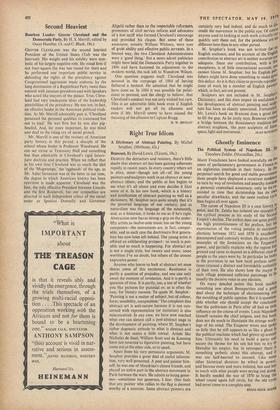Right TrueIdiom
A Dictionary of Abstract Painting. By Michel Seuphor. (Methuen, 42s.) ' Brancusi. By David Lewis. (Tiranti, 18s.)
DESPITE the detractors and resisters, there's little doubt that abstract art has been gaining adherents rapidly in recent years. In every country where art is alive, mOst—though not all—of the young
painters and sculptors work in an abstract or near- abstract idiom; - and the public at last begins to see what it's all about and even decides it likes some of it. In his new book,.which is a history and justification of abstract painting as well as a dictionary, M. Seuphor says quite simply that it's the pictorial language of our century, just as naturalism was the language of the nineteenth, and, as a historian, it looks to me as if he's right. Abstraction now has as strong a grip on the under- fifty artists as twelve-note music has on the young composers—the movements are, in fact, compar- able, and in each case the doctrinaire first genera- tion has now been left behind. The young artist is offered an exhilarating prospect : so much is pos- sible and so much is happening. For abstract art is not a single style, but twenty and more; some worthless I've no doubt, but others of the utmost expressive power.
Anyone who learns to look at abstract art soon shares some of this excitement. Resistance is partly a question of prejudice, and one can only await the moment of revelation. And it is partly a question of time. It is partly, too, a test of whether you like pictures for pictorial or, as is often the case, for literary reasons. To quote M. Seuphor : 'Painting is not a matter of subject, but of colour, form, sensibility, composition.' The complaint that abstract art is anti-nature because it is not con- cerned with representation (or imitation) is also misconceived. In any case, we have now reached what one can almost call a post-abstract stage in the development of painting, where M. Seuphor's rather dogmatic attitude to what is abstract and what is not seems a little unreal. Artists like Nicholas de Stael, William Scott and de Kooning have not reverted to figurative painting, but have come out at the other side, so to speak.
Apart from his very persuasive arguments, M. Seuphor provides a great deal of useful informa- tion, very well presented. A poet and painter him- self, he was one of Mondrian's closest friends, and played an active part in the abstract movement in Paris between the wars. He admits to being gener- ous—sometimes too generous, I fear. One feels that any painter who rallies to the flag is deemed worthy of a mention. Some abstract painters are certainly very bad indeed, and do much tc credit the movement in the public eye. Of o anyone used to looking at such work criticall quickly sort them out, for the problems al different here than in any other period.
M. Seuphor's book was not written for all English audience, and his account of the English contribution to abstract art is neither accurate adequate. adequate. Since our contribution, with a fey' exceptions, is of little international account, otte cannot blame M. Seuphor, but his English lishers might have done something to make . 0°`` this defect. As it is they claim to provide reprodue. tions of work by a number of English pal ters which, in fact, are not present. . Sculptors are not included in M. Seup or9 Dictionary, and this does impair its usefulness as the development of abstract painting and si ture has been so closely associated. Fortum telY, Mr. Lewis's book on Brancusi does a great 01 to fill the gap. As he justly says, Brancusi created, a bridge between the Renaissance tradition a°9 abstract scuplture, 'the pure sculpture of foal'


































 Previous page
Previous page